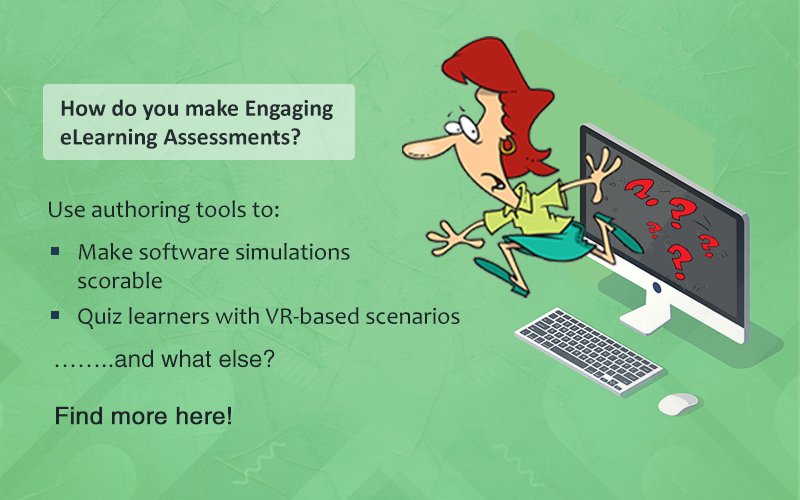Creating Effective eLearning Assessments Leveraging Various Formats [Infographic]
![Creating Effective eLearning Assessments Leveraging Various Formats [Infographic] Creating Effective eLearning Assessments Leveraging Various Formats [Infographic]](https://blog.commlabindia.com/hubfs/Imported_Blog_Media/Creating-Effective-eLearning-Assessments-Leveraging-Various-Formats-Infographic.jpg)
eLearning assessments are the primary tool for evaluating your learners’ knowledge, so they are tied to learning objectives, where learners are tested for the acquired knowledge and skills learnt. So, these assessments need a high level of interactivity to maximize learner engagement and propel continuous learning. Additionally, for the desired outcomes, the eLearning assessments must be precisely in line with the established learning objectives.
Wondering how to create the perfect eLearning assessments? Here’s an infographic with 4 amazing tips.
Various Formats to Leverage in eLearning Assessments
A diverse array of eLearning assessments formats are required for various eLearning considerations, so the selection of eLearning assessments is based on factors like the course’s learning objectives and its accessibility on the LMS. Let’s jump right into the most popular assessment formats that makes eLearning stand out-
1. Scenarios
Scenarios are a great way to assess knowledge because they let learners use it in a way that closely resembles a real-world situation. In this format, learners are given a scenario and asked to make decisions based on the circumstances. This format enables learning objectives to be achieved and knowledge gaps to be filled.
Benefits of implementing scenario-based assessment:
- Enhances one’s capacity for solving issues
- Curates an evaluation system similar to the real world
- Creates a setting for cultivating or developing skills
Quick Tip: Consider the learning objective when designing scenarios to make the most of them as eLearning assessments.
2. Multiple Choice
Multiple choice questions are a quick way to gauge learners understanding of the concept as they are brief and to the point which allows for a thorough evaluation of learner’s knowledge. Multiple-choice questions are those that pose a question and give the learner a selection of answers to choose from. There are two main types of multiple-choice questions: single-select and multiple-select. If they come in the form of how and why questions, they can also be used to gauge the degree of synthesis and analysis, two important components of Bloom’s Taxonomy.
Benefits of implementing multiple choice questions:
- Offers a bias-free evaluation because the chosen response is either clearly correct or incorrect
- Tends to be comprehensive and quick
- Serves as a reliable source of assessment
Quick tip: The learning objectives should be related to each multiple-choice question you include in your eLearning assessment.
→ Access Now: Interactive Templates for New-Age eLearning
3. Fill in the Blanks
Fill in the blanks as eLearning assessments are ideal to determine the learner’s knowledge as learners need to know the precise information because fill-in-the-blank questions aren’t opinion-based, learners must apply the information they’ve mastered throughout the lesson to answer them correctly. Learners have to type the missing word in a sentence in the blank. These reinforce learning and play an integral role in assessing learner’s knowledge. They leave little room for guessing.
Benefits of implementing fill in the blanks as eLearning assessments:
- Reduces the chance of guessing, producing accurate answers
- Offers quick knowledge check
Quick tip: Fill-in-the-blank assessments must be designed in a way that there is no ambiguity, giving keywords for the blanks can be a good practice to help learners determine the correct answer.
4. True/False
True/false questions are straightforward forms of assessment because they are direct and ask only for a true or false response. True/False questions ask a statement or a question, and the learner must select True or False as their answer. Since true/false questions are fact-based, they accurately measure a learner’s level of understanding because there is no room for responses from the learner’s perspectives; instead, the options are either true or false.
Benefits of implementing true/false as eLearning assessments
- Questions can be developed with few and simple words where learners need not spend much time reading it.
- This is a quick form of assessment that allows learners to answer 2-3 questions in a minute
Quick Tip : When asking a true or false question, it must be clear and without uncertainty where the question should be brief and contain only one idea.
5. Simulations
Simulations are a great way to assess learners knowledge for the job tasks where the real-life environment is mimicked for learners to apply the knowledge gained and practice. They shorten the duration and expense of training by giving learners a safe environment to practice. Since simulations mimic the real world, making a mistake here has no repercussions, allowing learners to practice without worrying about failing and learning from their errors. Simulations are excellent because it allows learners to practice handling real-world scenarios without fear of failing.
Benefits of implementing simulations as eLearning assessments:
- Offers a true-to-life learning experience
- Enables personalized assessments depending on various situations to be learned
Quick Tip: Add relatable avatars in simulations to create an impactful environment.
To Conclude
As assessments play a key role in evaluating learner’s knowledge, their proper creation and execution are important, so rather than just including them, design them effectively and witness the magic!
Do you want to easily design courses that are wonderfully creative, which will help your learners learn more effectively and retain it better? Then, checkout our interactive eLearning templates.



![eLearning Assessments: Leveraging Various Formats [Infographic] eLearning Assessments: Leveraging Various Formats [Infographic]](https://blog.commlabindia.com/hs-fs/hubfs/Imported_Blog_Media/elearning-assessments-various-formats-infographic-info.png?width=900&height=2200&name=elearning-assessments-various-formats-infographic-info.png)



![Plan Your eLearning Assessments Like a Pro! [SlideShare]](https://blog.commlabindia.com/hubfs/Imported_Blog_Media/elearning-assessments-plan-slideshare.jpg)